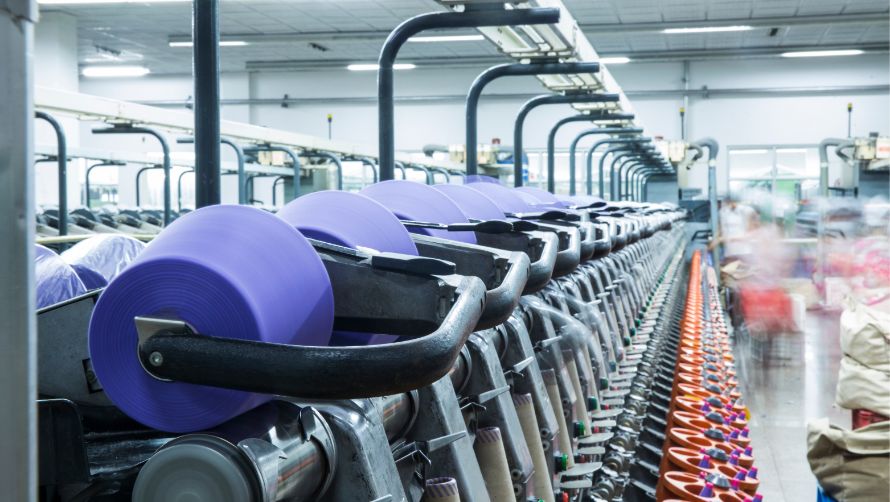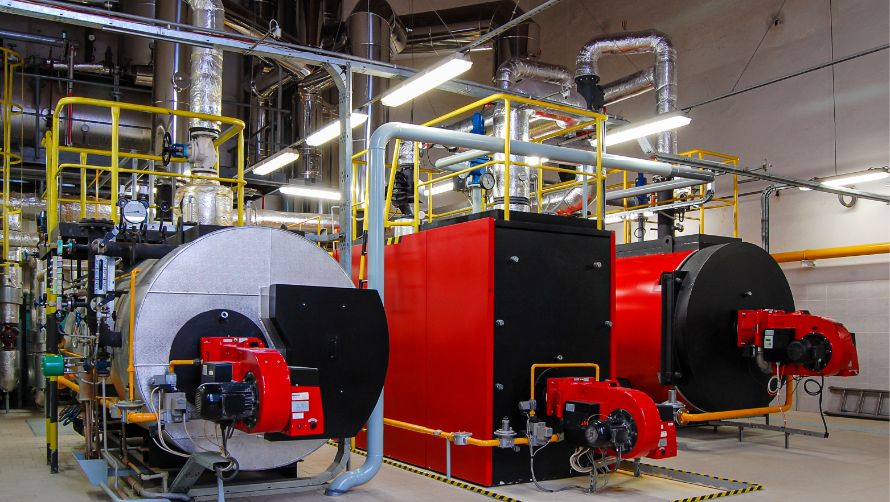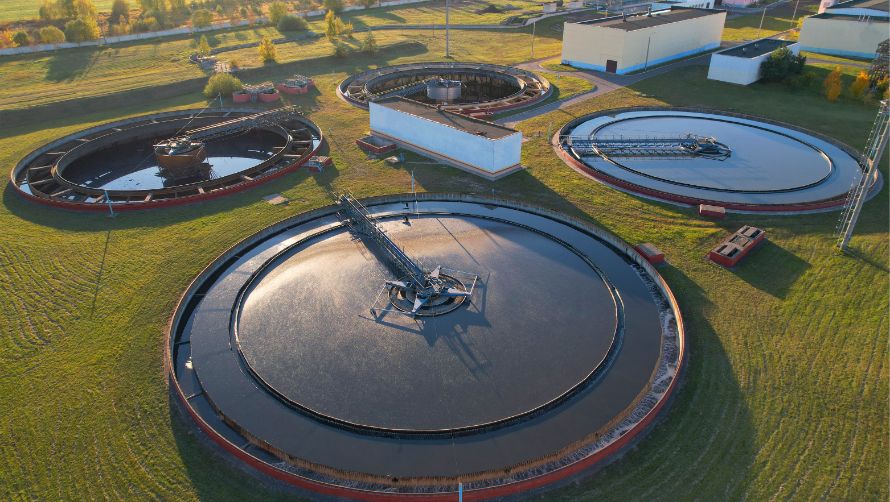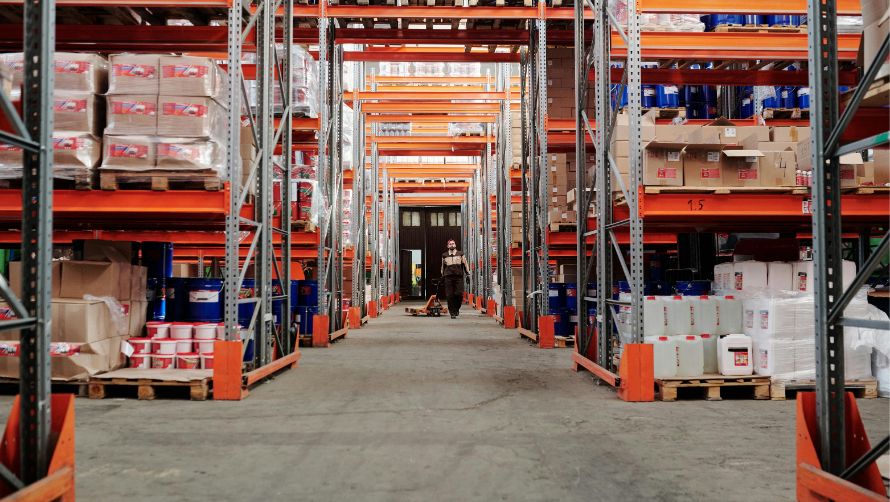The textile industry is one of the oldest and most vital industrial sectors globally, involving the production of yarn, fabric, and finished garments. It plays a crucial role in the global economy and is characterized by a wide range of processes — from raw fiber processing to dyeing, printing, and finishing. The industry encompasses both natural (cotton, wool, silk) and synthetic fibers (polyester, nylon, acrylic), with applications in clothing, home textiles, industrial fabrics, and technical textiles.
The Textile industry encompasses several processes. Here are some of the key processes in the Textile industry:
Pre-Treatment (Singeing + Scouring + Bleaching)

Pre-treatment is the first and most critical stage in textile processing, aimed at preparing raw fabric for dyeing or printing. It involves the removal of natural and added impurities from the fabric through a combination of thermal and chemical methods.
- Singeing removes surface fibers using direct flame or heated plates powered by LPG or natural gas.
- Scouring eliminates oils, waxes, and dirt using caustic soda (NaOH) at high temperatures.
- Bleaching whitens the fabric using chemicals like hydrogen peroxide (H₂O₂) or sodium hypochlorite (NaOCl), often under heat and pressure.
Types of Gases Present
Carbon Monoxide (CO) : from incomplete combustion in singeing burners or steam boilers.
Unburnt LPG / Natural Gas : leaks from burners or fuel lines.
Chlorine (Cl2): possible byproduct during bleaching with sodium hypochlorite.
Hydrogen Peroxide Vapors (H2O2) : from high-concentration bleaching.
Chemical Mist : from alkaline scouring with NaOH
Singeing Burner Area
Singeing machines use open flame burners powered by natural gas or LPG to burn off surface fibers. Poor combustion or pipeline damage can lead to leaks.
Fixed Point Detectors: Install combustible gas detectors and CO detectors near burners and gas supply lines.
Portable Detectors: Use portable multi-gas detectors during burner maintenance or inspections.
Steam Boiler Room
Boilers provide steam for scouring and bleaching. Incomplete combustion or faulty burners can emit CO or allow fuel gas to leak.
Fixed Point Detectors: Place CO and combustible gas detectors near boilers and fuel input points.
Portable Detectors: Use portable CO and flammable gas detectors during boiler inspection or confined space entry.
Chemical Dosing Area (Bleaching)
Chlorine or peroxide vapors may escape during the storage or dosing of bleaching agents like NaOCl and H₂O₂.
Fixed Point Detectors: Install Cl₂ and H₂O₂ detectors near dosing tanks, pipelines, and ventilation ducts.
Portable Detectors: Use portable toxic gas detectors when handling concentrated bleaching agents or in case of spills.
Open Scouring Tanks
High-temperature scouring can emit caustic mists or vapors when NaOH is used.
Fixed Point Detectors: Install area monitors or mist detectors above tanks and near exhaust vents.
Portable Detectors: Use portable pH or chemical mist detectors during cleaning or chemical loading.
Dyeing

Dyeing is a central process in the textile industry that involves applying dyes or pigments to textiles to achieve desired colors.
It is typically performed using jet dyeing, winch dyeing, jigger dyeing, or continuous dyeing machines.
The process requires elevated temperatures, steam, and chemical auxiliaries like carriers, leveling agents, and pH regulators.
Steam is generated through boilers (fueled by natural gas or LPG), and the dye baths often include reactive chemicals.
Due to the use of pressurized vessels and flammable or toxic additives, dyeing presents multiple gas leak and safety hazards.
Types of Gases Present
Carbon Monoxide (CO) : Released from incomplete combustion in boilers used for steam.
Methane(CH4) / Propane (C3H8) : May leak from fuel lines supplying burners or steam generators.
Volatile Organic Compounds (VOCs) :Emitted from solvents and dye carriers, especially in synthetic dyeing.
Ammonia (NH3) : Sometimes used in pH adjustment or special dyeing applications.
Boiler Room (Steam Generation)
Boilers are used to generate steam for heating dye baths. Gas burner faults can cause incomplete combustion or gas leaks
Fixed Point Detectors: Install CO and combustible gas detectors near the boiler and fuel supply valves.
Portable Detectors: Use portable detectors for CO and flammable gases during maintenance or inspection.
Dyeing Machine Area
Dyeing vessels operate at high temperature and pressure, potentially releasing steam, VOCs, or residual fuel gases.
Fixed Point Detectors: Install VOC detectors in closed dye rooms and combustible gas detectors near any burner-heated systems.
Portable Detectors: Use portable VOC or multi-gas detectors during manual dyeing operations or when opening vessels.
Chemical Dosing Area (Bleaching)
Chemicals used for dyeing may include ammonia, solvents, or organic carriers that can vaporize and leak.
Fixed Point Detectors: Place NH₃ and VOC detectors near storage tanks and dosing lines.
Portable Detectors: Use portable gas detectors when refilling or transporting dyeing chemicals.
Finishing & Drying (Stenter Machines)

Finishing is the final wet processing stage in the textile industry, aimed at enhancing fabric properties such as softness, wrinkle resistance, dimensional stability, and water repellency.
Drying is often combined with finishing, especially in stenter machines, where fabric is stretched and dried using hot air generated by LPG or natural gas burners.
Chemical finishes such as formaldehyde-based resins, silicones, or anti-microbial agents are applied to fabrics, some of which release toxic or flammable vapors under heat. The combination of high temperature, flammable fuel, and chemical vapors makes this process a major gas hazard area.
Types of Gases Present
Carbon Monoxide (CO) : Formed due to incomplete combustion in stenter machine burners.
Methane(CH4) / Propane (C3H8) : May leak from burners or gas supply lines
Formaldehyde (CH2O) : Emitted during the application and curing of formaldehyde-based resins.
Ammonia (NH3) : Sometimes used in pH adjustment or special dyeing applications.
Stenter Burner Section
Stenter machines use natural gas or LPG burners to generate hot air for drying. Faulty burners or pipelines can cause fuel leaks or CO emissions.
Fixed Point Detectors: Install CO and combustible gas detectors near burners and gas manifolds.
Portable Detectors: Use portable detectors to check for gas leaks during machine startup, maintenance, or after shutdown.
Chemical Finishing Application Zone
Resins and softeners applied here may release harmful vapors like formaldehyde, especially under heat.
Fixed Point Detectors: Install formaldehyde and VOC detectors near application and curing zones.
Portable Detectors: Use portable toxic gas detectors during chemical handling or when entering poorly ventilated areas.
Exhaust Ventilation / Ducting
Hot air ducts may carry vaporized chemicals and combustion gases. If not properly exhausted, buildup can occur.
Fixed Point Detectors: Place VOC or formaldehyde detectors near ducts and exhaust outlets.
Portable Detectors: Use portable detectors for spot-checking near ducts and during routine air quality assessments.
Boiler House (Steam Generation)

The Boiler House is responsible for generating steam, which is used across multiple textile processes, such as dyeing, scouring, and bleaching.
Boilers typically operate on natural gas, LPG, or oil as fuel, and they heat water to create steam. The combustion process produces heat, but if not properly managed, it can lead to gas leaks or incomplete combustion, resulting in the emission of dangerous gases like carbon monoxide (CO).
The Boiler House is a critical area for safety due to the presence of highly flammable fuel, high-pressure systems, and potential for toxic gas exposure
Types of Gases Present
Carbon Monoxide (CO) : Produced from incomplete combustion in burners, especially when boilers are poorly maintained.
Methane(CH4) / Propane (C3H8) : Leaks from gas lines, valves, or burner connections
Nitrogen Oxides (NOx) : Generated during the combustion of fossil fuels in the boiler
Sulfur Dioxide (SO2) : Possible from the burning of certain fuels containing sulfur.
Burner and Combustion Chamber
Boilers use gas burners to ignite and heat the water. Faults in the burner or combustion chamber can lead to unburned fuel gas, CO, and NOx emissions.
Fixed Point Detectors: Install CO and combustible gas detectors near burners, combustion chambers, and gas supply lines.
Portable Detectors: Use portable detectors for maintenance checks on burner systems or during routine inspections.
Fuel Lines and Valves
Fuel gas pipelines, valves, and fittings are prone to leakage due to wear, corrosion, or improper seals. Leaks can lead to flammable gas buildup.
Fixed Point Detectors: Install combustible gas detectors near fuel lines and valve connections.
Portable Detectors: Use portable detectors to spot-check fuel lines during maintenance or inspection, particularly in confined spaces.
Exhaust Stack / Ventilation
The exhaust stack releases gases such as CO, NOx, and SO₂ into the atmosphere. Malfunctions in the stack or exhaust system can lead to dangerous emissions.
Fixed Point Detectors: Install CO and NOx detectors at exhaust points to monitor for toxic gases escaping from the stack.
Portable Detectors: Use portable detectors to test emissions for compliance with air quality regulations and during scheduled inspections.
Boiler Room (General Area)
The boiler room, a confined space with potential for gas buildup, requires constant monitoring for both combustible gases and oxygen levels.
Fixed Point Detectors: Install Oxygen and combustible gas detectors throughout the boiler room.
Portable Detectors: Use portable multi-gas detectors for confined space entry to monitor O2 levels and detect leaks of combustible or toxic gases
Effluent Treatment Plant (ETP)

The Effluent Treatment Plant (ETP) is crucial in managing and treating wastewater generated during textile processing, particularly from dyeing and finishing.
The plant neutralizes and treats hazardous chemicals, such as acids, alkalis, and heavy metals, before discharging the treated water.
The ETP utilizes various processes, including coagulation, flocculation, chemical dosing, and biological treatment. It may also involve anaerobic or aerobic digestion, where gases like hydrogen sulfide (H₂S), ammonia (NH₃), or chlorine (Cl₂) can be emitted, posing significant safety risks.
Given the presence of toxic chemicals and the potential for gas leaks, proper monitoring is essential for worker safety.
Types of Gases Present
Hydrogen Sulfide (H2S): Released from the anaerobic treatment of wastewater, especially with organic waste
Ammonia (NH3) : Emitted during neutralization or chemical dosing when handling ammonia-based compounds.
Chlorine (Cl2) : Potentially released when using chlorine-based disinfectants or during the treatment of bleaching agents.
Carbon Dioxide (CO2): Produced during aerobic treatment or from chemical reactions
Volatile Organic Compounds (VOCs) : Emitted from solvent-based chemicals used in treatment or cleaning processes.
Chemical Dosing Area
The addition of chemicals, including chlorine or ammonia, into the treatment tanks can result in hazardous gas leaks if not properly controlled.
Fixed Point Detectors: Install NH₃ and Cl₂ detectors near chemical storage tanks, dosing lines, and dosing stations.
Portable Detectors: Use portable detectors for spot checks during the chemical addition process or when handling containers.
Anaerobic Treatment Tanks
Anaerobic treatment processes can produce hydrogen sulfide (H₂S), a toxic and flammable gas, especially when organic material is decomposed without oxygen.
Fixed Point Detectors: Install H₂S detectors near treatment tanks, gas vents, and exhausts.
Portable Detectors: Use portable H₂S detectors during maintenance or when entering confined spaces around treatment tanks.
Aerobic Treatment or Bio-digester Tanks
Aerobic digestion can produce carbon dioxide (CO₂) and sometimes methane (CH₄), especially when organic waste is broken down in the presence of oxygen.
Fixed Point Detectors: Install CO2 and combustible gas detectors near aeration tanks or bio-digesters.
Portable Detectors: Use portable gas detectors to monitor O2 levels and combustible gases in confined spaces or during inspections.
Exhaust Fans and Ventilation Ducts
Ventilation systems used to disperse gases from treatment processes can carry toxic fumes and volatile organic compounds if leaks or malfunctions occur.
Fixed Point Detectors: Install VOC and toxic gas detectors in exhaust ducts, near fans, and ventilation outlets.
Portable Detectors: Use portable gas detectors during routine checks or repairs on ventilation systems.
Storage & Chemical Handling

Storage and chemical handling areas in textile plants manage large volumes of dyes, solvents, acids, alkalis, and finishing agents.
These chemicals are stored in tanks, drums, or silos, and are transferred manually or via automated systems to processing areas. Improper storage, faulty transfer systems, or accidental spills can lead to hazardous gas emissions.
Many of these chemicals are flammable, toxic, or corrosive, posing serious risks to workers and facilities if not properly monitored
Types of Gases Present
Formaldehyde (CH2O) : May vaporize from resin-based finishes stored in drums.
Ammonia (NH3) : Released from pH regulators or neutralizing agents.
Chlorine (Cl2) : Emitted from bleach storage or dosing systems.
Hydrogen Peroxide Vapors (H2O2) : Can escape from concentrated peroxide containers.
Volatile Organic Compounds (VOCs) : From solvents, carriers, and auxiliary agents.
Chemical Storage Tanks & Drums
Leaks can occur due to overfilling, corrosion, or faulty valves in tanks or containers storing chemicals.
Fixed Point Detectors: Install NH₃, Cl₂, and VOC detectors near tanks, container racks, and chemical storage zones.
Portable Detectors: Use portable detectors during chemical inventory checks, drum transfers, or in response to odor complaints.
Chemical Transfer Lines / Pumps
Pipelines and pumps transferring chemicals to production units can develop leaks from seals, gaskets, or improper connections.
Fixed Point Detectors: Place VOC, Cl₂, or formaldehyde detectors near pump stations and along transfer lines.
Portable Detectors: Use portable gas detectors for leak detection during chemical line maintenance or emergency response.
Unloading Bays (Tanker to Storage)
Bulk chemicals are often delivered via road tankers and transferred to storage tanks. Spills or hose leaks during transfer can release hazardous vapors.
Fixed Point Detectors: Install combustible and toxic gas detectors at unloading bays and near hose connection points.
Portable Detectors: Use portable gas detectors during all bulk transfer operations for real-time monitoring.
Chemical Waste Storage
Improperly segregated or stored chemical waste can lead to unexpected chemical reactions and gas releases.
Fixed Point Detectors: Place multi-gas detectors near chemical waste containers and designated disposal zones.
Portable Detectors: Use portable detectors during sorting, moving, or disposing of chemical waste to check for unexpected emissions.
